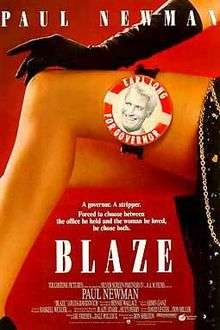Blaze (1989 film)
Blaze is a 1989 American comedy-drama film written and directed by Ron Shelton. Based on the 1974 memoir Blaze Starr: My Life as Told to Huey Perry by Blaze Starr and Huey Perry, the film stars Paul Newman as Earl Long and Lolita Davidovich as Blaze Starr, with Starr herself in a cameo appearance.
| Blaze | |
|---|---|
 Theatrical release poster | |
| Directed by | Ron Shelton |
| Produced by | |
| Screenplay by | Ron Shelton |
| Based on |
|
| Starring | |
| Music by | Bennie Wallace |
| Cinematography | Haskell Wexler |
| Edited by | Robert Leighton Michael King |
Production company | |
| Distributed by | Buena Vista Pictures |
Release date |
|
Running time | 120 minutes |
| Country | United States |
| Language | English |
| Budget | $22 million[1] |
| Box office | $19,131,246 |
Plot
The film tells the highly fictionalized story of the latter years of Earl Long, a flamboyant Governor of Louisiana, brother of assassinated governor and U.S. Senator Huey P. Long and uncle of longtime U.S. Senator Russell Long. According to the novel and film, Earl Long allegedly fell in love with a young stripper named Blaze Starr.
Cast
- Paul Newman as Governor Earl Long
- Lolita Davidovich as Blaze Starr
- Jerry Hardin as Thibodeaux
- Gailard Sartain as LaGrange
- Jeffrey DeMunn as Eldon Tuck
- Richard Jenkins as Picayune
- Brandon Smith as Arvin Deeter
- Robert Wuhl as Red Snyder
- James Harper as Willie Rainach
- Rod Masterson as Alexandria Daily Town Talk Reporter
Reception
The film received mixed reviews from critics.[2][3]
Box office
Blaze debuted at number 9 at the North American box office on its opening weekend.[4]
References
- http://catalog.afi.com/Film/57925-BLAZE
- Benson, Sheila (1989-12-13). "MOVIE REVIEW : 'Blaze' Sizzles Even Over Low Flame". Los Angeles Times. Retrieved 2012-07-06.
- Maslin, Janet (1989-12-13). "Movie Review - Blaze - Review/Film; 'Blaze,' a Story of a Rogue and a Stripper". The New York Times. Retrieved 2012-07-06.
- "Weekend Box Office". Los Angeles Times. Retrieved 2012-06-13.